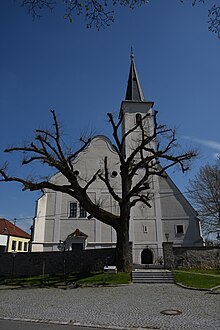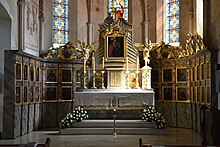Rattersdorf pilgrimage church
The Roman Catholic parish and pilgrimage church in Rattersdorf in the municipality of Mannersdorf an der Rabnitz in the Oberpullendorf district in Burgenland is a listed building . It is dedicated to the Birth of Mary and the Visitation of the Virgin Mary .
history
The foundation of a parish and probably also the beginning of the pilgrimage took place around 1300. The church was destroyed in 1352. From 1660 to 1820 the parish was incorporated into the Augustinian Hermit Monastery in Lockenhaus. The church was restored under Prince Paul Esterházy . A complete restoration took place from 1962 to 1966.
architecture
The church in the center of the village is enclosed by a defensive wall around a former cemetery. The medieval, partly Baroque-style building consists of two churches that have grown together. The west facade is slightly bent to the right of the tower that has just been integrated. The tower has an upper floor with a pointed spire from 1696. The choir of the northern part of the church has double buttresses and baroque windows. The choir of the southern part of the church also has double stepped buttresses with Gothic pointed arch windows. The entire south building has an axis shifted slightly to the south, which slightly nips the west facade and widens the east side somewhat. The facade is designed with a baroque fascia structure. The main portal bears Esterhásy's coat of arms in the blown gable and shows a mask and tendrils in the frieze. The portal to the tower chapel is from the end of the 13th century. The south portal from 1502 has a late Gothic frame.
The oldest part of the church from the 13th century is the tower chapel in the basement, accessible via an internal staircase. This is followed by the southern two-bay part of the church, originally a flat-roofed central nave, then with cross vaults with single grooved ribs without consoles. The triumphal arch is Gothic. The one-yoke choir with a five-eighth end has pear ribs with two console heads from the 14th century. According to an inscription on the east wall, the south aisle was added in 1502 and has a two-bay cross vault made of flat grooved ribs. There is a confessional chapel under the deep gallery.
The church, which was added to the north in the 15th century, was newly vaulted in 1696 and opened with arcades to the older building in the south. The northern four-bay nave is vaulted with a barrel with stitch caps and has a pilaster structure. The apse with three-eighth closure has stitch caps between straps.
Furnishing
The altar of grace in the central nave with a flat structure and a gilded frame is from the end of the 18th century and shows the miraculous image of Maria lactans with the foundation inscription 1644. A copy from 1660 after the original 1644 is in the parish church Lockenhaus . Behind the altar of grace is a remarkable picture wall with tendrils and a coat of arms from the 3rd quarter of the 18th century. Inlaid are two rows of oil paintings, above with saints of the Augustinian Order of Hermits, below Christ and Apostles, probably painted by Brother Jonas from Lockenhaus. Behind the picture wall there are remains of late medieval frescoes.
The high altar of the north church, created around 1700 and changed in 1790, is a columnar altar with a vertical gable and top and shows the images of the Visitation of the Virgin and God the Father . The baroque figures Katharina and Barbara stand above the sacrificial portals.
There are three side altars in the niches of the north wall: The Holy Cross altar bears an unmounted crucifixion group from the 1st quarter of the 18th century. The Anna altar from the 3rd quarter of the 18th century shows the picture Anna with Maria and carries the figures Joseph and Joachim below and Johannes the Baptist and Wendelin above. The Antonius-von-Padua altar from the 3rd quarter of the 18th century bears the figure of Antonius in the middle.
The baptismal font was built at the end of the 17th century and has a hump-backed bowl with a Moor figure with an Anabaptist group. The pulpit was built around 1790. There is a former miraculous image from the 2nd half of the 17th century with crowns in an acanthus frame with a clothed statue analogous to the miraculous image in Frauenkirchen in the middle of the high altar of the north church. In front of the altar of grace hangs a traffic light as an Augsburg silver work around 1740.
The organ is from the end of the 18th century.
Quelle, Marienkapelle and rectory
There is a contained healing miracle spring on the east side of the church in the former cemetery. The Lady Chapel from the 18th century on the east side of the former cemetery is a square building with a curved gable and a square vault. The flat columnar altar from the first half of the 18th century shows a picture of Mary and the figures Magdalena and Barbara, painted and sawn out on boards.
The parsonage from the 19th century next to the church has an arcade.
literature
- The art monuments of Austria. Dehio Burgenland 1976 . Rattersberg, Catholic parish and pilgrimage church Mariae Birth and Mariae Himmelfahrt, pp. 246–247.
Web links
Coordinates: 47 ° 24 ′ 31.5 " N , 16 ° 29 ′ 56.4" E



